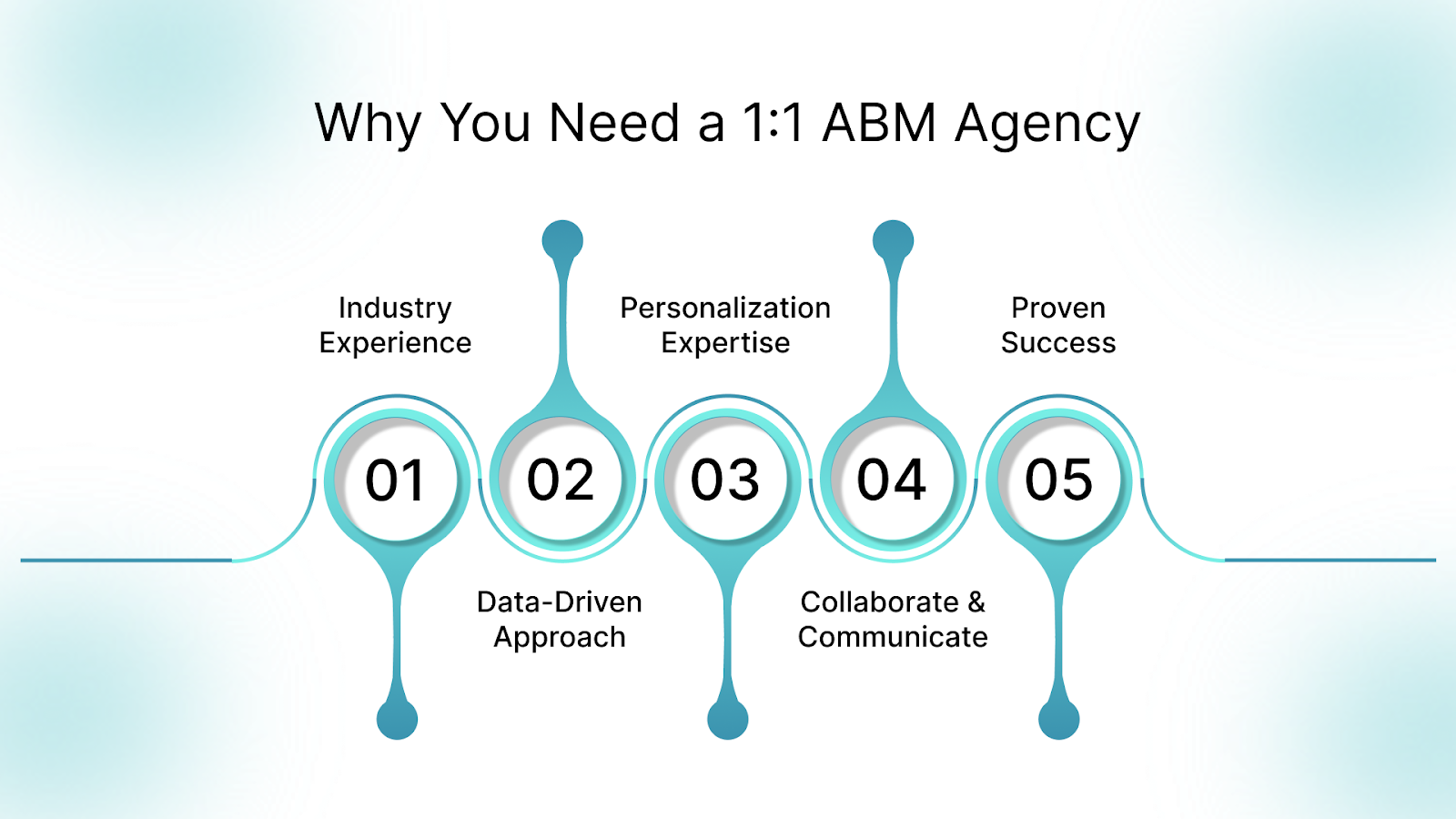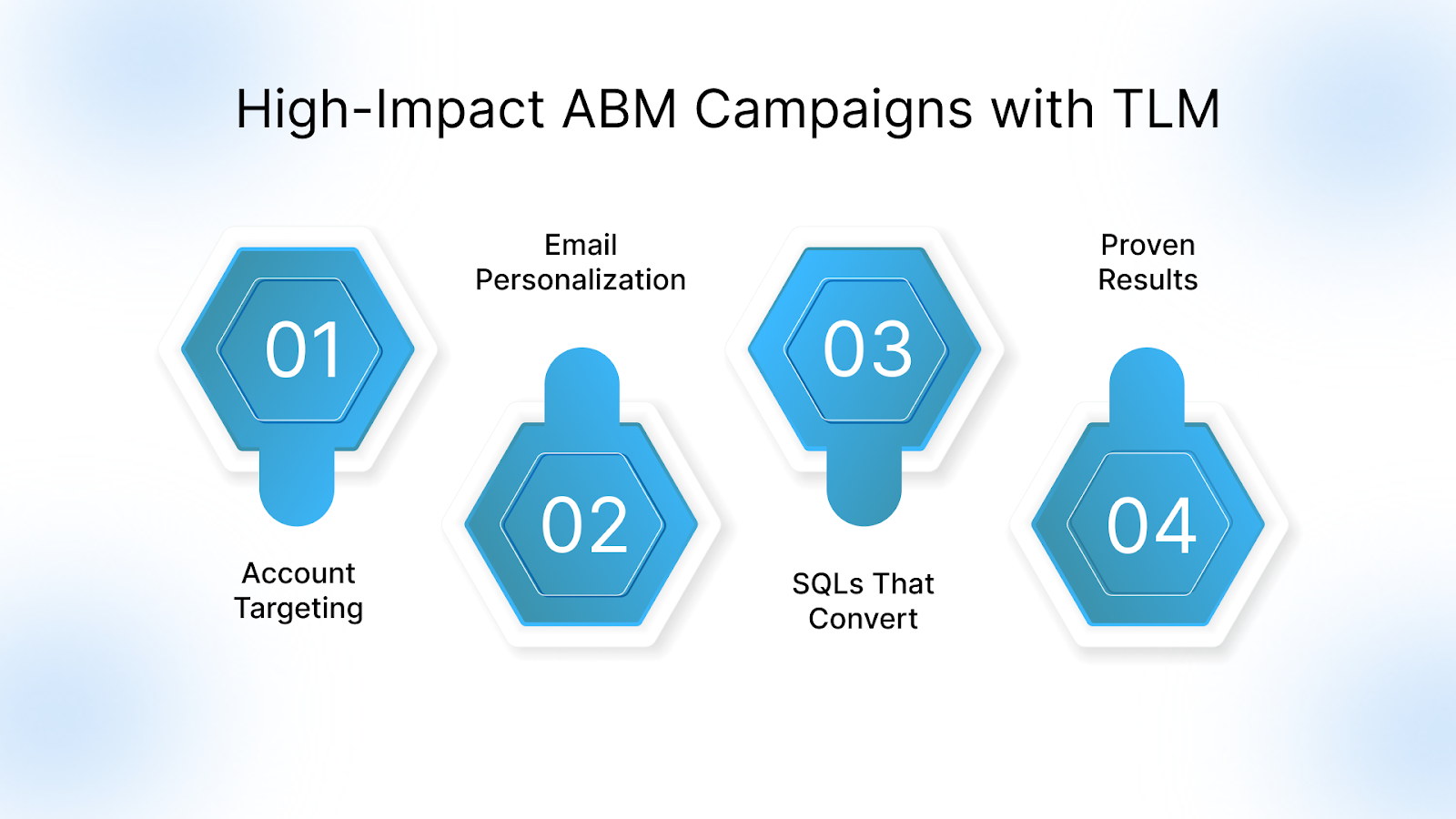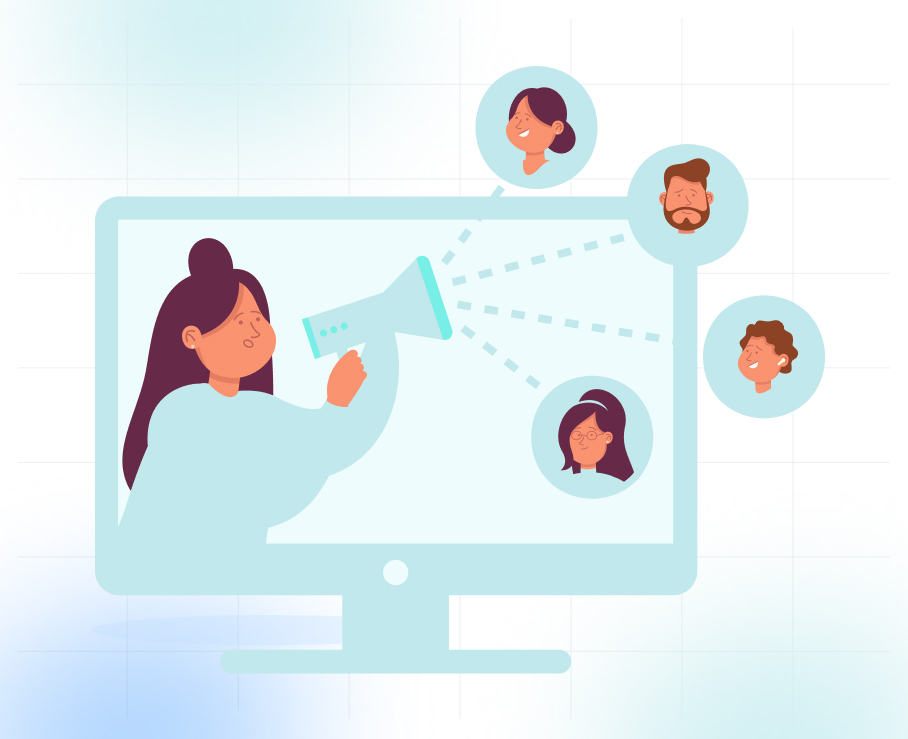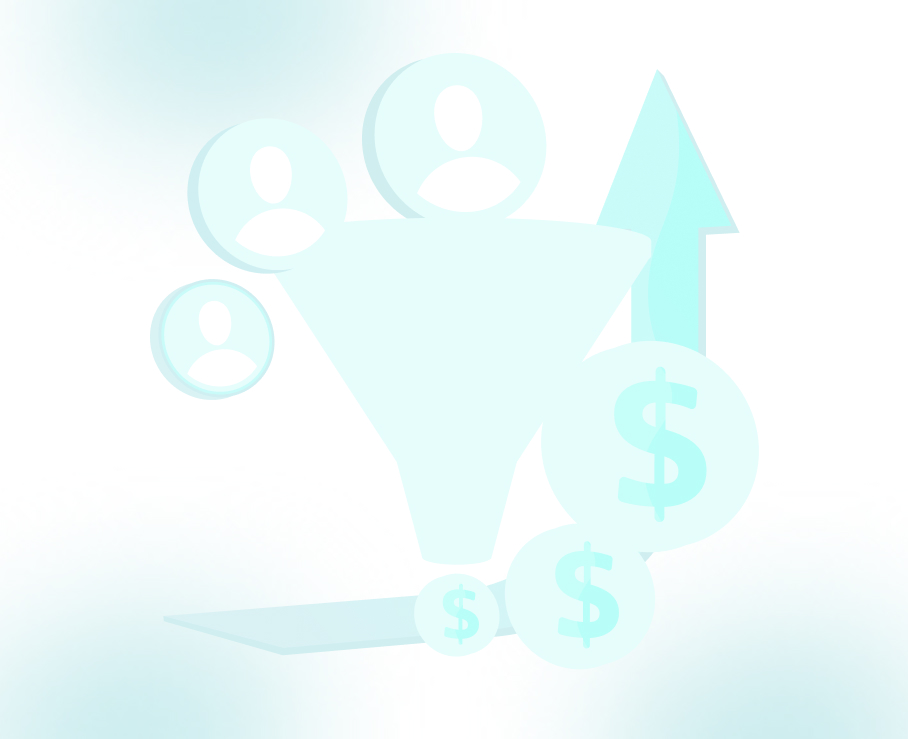
Guide to Running Effective 1:1 ABM Campaigns

Think of marketing like planting seeds. The traditional approach involves scattering seeds everywhere, hoping a few will take root. You might see some growth, but much of your effort goes to waste, and results are unpredictable.
Now, imagine carefully planting each seed in the soil where it's most likely to thrive, giving it the attention and care it needs to flourish. That's the power of 1:1 ABM, targeting the right accounts with personalized strategies that increase your chances of success and make every effort count.
If you're ready to stop wasting time and resources, this guide will show you how to run a 1:1 ABM campaign that drives meaningful, measurable results.
Let's explore how this focused approach can accelerate your growth and build lasting relationships with the accounts that matter most.
TL;DR
- 1:1 ABM helps you win fewer but better accounts through deep personalization
- Email-led outreach still drives the most consistent B2B results
- Sales and marketing alignment makes or breaks ABM success
- A specialized agency like TLM can scale your ABM without losing relevance
What is 1:1 ABM?
1:1 Account-Based Marketing is a personalized B2B strategy where you focus your outreach on a shortlist of high-value accounts, crafting every message, touchpoint, and campaign specifically for them.
Unlike traditional lead gen that casts a wide net, 1:1 ABM uses tailored messaging, account-level research, and direct engagement to reach the right decision-makers at the right time.
This often involves deep email personalization, content that speaks to account-specific pain points, and a close sales-marketing collaboration.
For companies in complex B2B industries, like managed IT, staffing, software, and manufacturing, this approach reduces lead waste, improves sales efficiency, and delivers a stronger ROI.
Key Benefits of 1:1 ABM

1:1 ABM goes beyond brand awareness; it’s about measurable outcomes. For B2B industries like managed IT, staffing, and tech, where sales cycles are long and every touchpoint matters, this strategy ensures your efforts land with the right people.
Here's how 1:1 ABM delivers real value:
- Higher Conversion, Lower Waste: By tailoring outreach to specific accounts, 1:1 ABM drastically cuts down on unqualified leads. Every message is crafted for a real decision-maker, leading to better engagement and more SQLs.
- Stronger ROI, Higher MRR: Unlike mass campaigns, personalized ABM efforts directly impact pipeline health. When done right, they shorten sales cycles and increase Monthly Recurring Revenue (MRR)—a key metric for growing B2B companies.
- Deep Sales-Marketing Alignment: ABM requires tight collaboration across teams. Marketing creates tailored content and messaging, while sales leverages those assets for direct, account-specific conversations.
- Laser-Focused Targeting: With tools like a proprietary email outreach platform, every campaign is backed by data—firmographics, engagement history, past interactions—to ensure you're not just reaching out, but reaching right.
- Relationship-Led Growth: Because you're solving problems specific to each account, trust builds faster. This strengthens long-term customer relationships and increases retention over time.
Steps to Create an Effective 1:1 ABM Campaign

Creating a successful 1:1 ABM campaign goes beyond simply targeting potential customers; it requires a strategic, personalized approach that resonates with high-value accounts.
Here's how to build a high-performing ABM strategy from start to finish:
1. Identify and Select High-Value Accounts
The foundation of any ABM campaign is selecting the right accounts to target. This step goes beyond simple demographics and requires an in-depth analysis of potential accounts to ensure you are focusing on the highest-value opportunities.
Start by defining your Ideal Customer Profile (ICP)—typically companies in your sweet spot based on:
- Industry (e.g., Managed IT, Staffing, SaaS, or Manufacturing)
- Company size and headcount
- Decision-maker roles (Sales Directors, CTOs, Founders)
- Pain points you’re uniquely equipped to solve
Leverage tools like:
- Internal historical win/loss data
- Retargeting lists of past but lost prospects
- Engagement from email campaigns or gated content
2. Conduct In-Depth Account Research
Once you've identified high-value accounts, the next step is to gather comprehensive insights about each one.
Deep account research helps uncover key details that will shape your outreach and personalization efforts.
Here's what to uncover:
- Company Objectives & Current Challenges: What strategic initiatives are they pursuing this quarter? Where's the friction? For example, MSPs might be struggling with service downtime or retention; your messaging should speak directly to those gaps.
- Decision-Maker Personas: Who actually owns the budget? Map out influencers and champions across the org. Craft tailored value props for each, especially across sales and IT leadership.
- Past Interactions & Email Engagement: Use data from previous email touches (opens, replies, link clicks) to gauge familiarity and relevance.
- Competitive Positioning: Who are their main vendors or solutions now? Knowing where you win (faster delivery, lower churn, etc.) lets you differentiate meaningfully.
Pro Tip: Combine firmographic, intent, and email behavior to create an actionable profile, not a spreadsheet full of noise.
3. Craft Personalized Campaigns
With detailed profiles in hand, it's time to create campaigns that speak directly to each account's needs and goals. Personalization is essential in 1:1 ABM, ensuring your messages are both relevant and engaging.
Here's an example of how you can structure your personalized email outreach:
- Subject Line: Craft a subject line that grabs attention and is directly relevant to the account's business. It should hint at a solution or benefit specific to their pain points, making it clear that this email is tailored for them.
- Email Body: In the body of the email, address the account's challenges directly. Keep the content concise and focused on how your solution can help. Personalize the message with references to their industry, past interactions, or specific needs.
- Clear Call-to-Action (CTA): Your CTA should be clear and actionable, guiding the recipient towards the next step. Whether it's scheduling a call or requesting a demo, ensure the CTA directly aligns with their current needs and encourages quick engagement.
Liked what you read? Let’s turn these strategies into real B2B appointments.
4. Execute Multi-Channel Outreach
Effective 1:1 ABM outreach isn’t about showing up on every channel; it's about showing up in the right places with the right message at the right time.
While multiple channels may be involved, personalized email remains the most direct and scalable way to reach decision-makers.
Here’s how to structure your outreach mix:
- Email as the Core Channel: Start with behavior-based email sequences tailored to each account. Emails should reflect the account's industry, business goals, and pain points. Ensure all outreach is fully CAN-SPAM compliant, with clear opt-out options and no list scraping.
- No Cold Calling. No LinkedIn Messaging: This is about building trust, not pushing pitches. Avoid unsolicited phone calls or DMs. Focus on opt-in conversations that reflect thoughtful intent and relevance.
5. Align Sales and Marketing Teams
Alignment between sales and marketing is critical for 1:1 ABM success. Both teams need to work together seamlessly to ensure that your efforts are coordinated and that you're providing the most relevant information to each account at the right time.
Here's how you can align sales and marketing teams:
- Shared Goals and Metrics: Set common goals and KPIs to measure the success of the campaign, such as engagement rates, conversion rates, or sales pipeline growth.
- Collaboration on Content: Marketing provides the tailored content, while sales engages directly with the account. Ensure both teams share knowledge about the account's pain points, objections, and progress in the sales funnel.
- Constant Communication: Regular meetings between sales and marketing allow both teams to stay updated on the campaign's progress and make necessary adjustments to messaging or tactics.
When both teams are aligned, the process becomes more fluid and the overall strategy more effective, ensuring a seamless experience for the target accounts.
Suggested Read: Benefits of Inside Sales: How it Transforms Business Outcomes
6. Track and Measure Results
After launching the ABM campaign, measuring its success and tracking key performance metrics is essential. Doing this lets you assess which tactics are working and which areas need improvement.
Important metrics to monitor include the following:
- Engagement Rates: How often do target accounts interact with your emails, content, or outreach efforts?
- Conversion Rates: How many of the targeted accounts are moving through the sales funnel, from initial engagement to conversion?
- Pipeline Growth: Is the campaign helping to build a robust sales pipeline, with more high-quality leads entering the process?
- MRR Impact: The ultimate test of any ABM campaign is how it affects Monthly Recurring Revenue.
Analyzing these metrics lets you fine-tune your strategy and identify areas to optimize.
Suggested Read:
7. Optimize and Scale
A great 1:1 ABM campaign doesn’t end after launch, it evolves. What works for 5 accounts won’t automatically work for 50. Scaling successfully requires continuous testing, smart automation, and crystal-clear visibility into what’s moving accounts toward conversion.
Here’s how to optimize and scale without sacrificing impact:
- A/B Test Message Variants and Content Formats: Test different email subject lines, landing page offers, or even CTA phrasing. Small tweaks can significantly improve engagement.
- Segment Accounts by Buying Behavior: Not all accounts respond the same way. Group accounts by engagement type, fast movers, late-stage researchers, and passive openers.
- Use Automation: As your campaigns grow, automation tools can help scale outreach efforts while maintaining a personalized touch.
Optimization is about finding your repeatable motion. Once you know what drives conversions, scaling becomes a question of execution.
What is a 1:1 ABM Agency and Why You Need One

Partnering with a 1:1 ABM agency can significantly elevate your campaign, bringing expertise to create a highly personalized and targeted campaign for your most valuable accounts.
When selecting the right 1:1 ABM agency, it's important to consider a few key factors to ensure they align with your goals:
- Industry Experience: Choose an agency that understands your market and has worked with similar companies, ensuring relevant and effective strategies.
- Data-Driven Approach: Ensure they use analytics to inform decisions, track key metrics, and adjust strategies for optimal results.
- Personalization Expertise: The agency should excel in crafting customized messaging and content for each target account.
- Collaboration and Communication: Choose an agency that will work closely with your internal teams to align on goals and messaging.
- Proven Success: Check their track record through case studies or client testimonials to verify they can deliver measurable results.
Carefully considering these factors will help you select the right 1:1 ABM agency to drive the success of your campaign and achieve your business objectives.
TLM: Your Partner for High-Impact ABM Campaigns

At TLM (The Lead Market), we don't just help you reach your top accounts; we help you convert them.
We specialize in email-first, compliant ABM campaigns that generate real, measurable outcomes: Sales Qualified Leads, booked appointments, and increased MRR.
Here's what sets us apart:
- Precision Account Targeting: We handpick high-fit accounts based on your ideal customer profile, then tailor every touchpoint to their needs.
- Email-Driven Personalization: Our proprietary outreach systems ensure each message stands out with hyper-personalized subject lines, content, and CTAs.
- SQLs That Convert: We don't just track sent emails, we analyze pipeline impact. Our ABM strategies are built to deliver SQLs that your sales team can close.
- Proven Results Across Industries: From MSPs to SaaS firms, our clients see higher engagement, shorter sales cycles, and stronger pipeline health.
Final Thoughts
A well-executed 1:1 ABM strategy enables you to focus your resources on high-value accounts that align with your business goals. By prioritizing personalization, aligning sales and marketing, and engaging decision-makers with relevant messaging, you can drive stronger conversion rates and long-term relationships.
At TLM, our email-first strategies, combined with proprietary tools and industry focus, help you move beyond awareness and into meaningful conversations with the right accounts.
FAQs
1. How many accounts should I target in a 1:1 ABM campaign?
You'll want to focus on a very small number, usually 5–10 high-value accounts, to ensure deep personalization and impact.
2. What should I personalize for each target account?
Go beyond names, tailor subject lines, messaging, pain points, content assets, and even landing pages based on each account's objectives, challenges, and organization structure.
3. How long do 1:1 ABM campaigns take to produce results?
Expect a long-term approach, typically 6 to 18 months, with early signs of engagement (meetings booked, pipeline influence) coming in the first quarter.
4. What's the optimal channel mix for 1:1 ABM?
Email remains the core channel, often supplemented by targeted ads (e.g., programmatic or LinkedIn) and personalized landing experiences.
5. How do I measure success in 1:1 ABM?
Track engagement signals, meetings booked, pipeline influenced, deal velocity, and don't forget to align on account-level metrics between marketing and sales.





